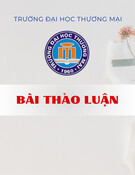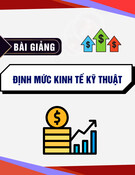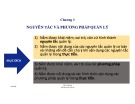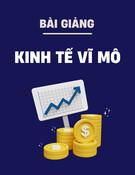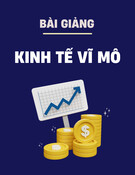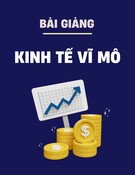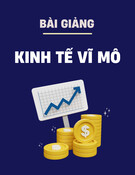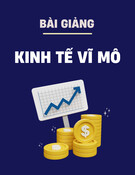
Managerial Economics – MBA – HSB – Huy Nguyen, 9/2020
1
Homework 3
MARKET AND DEMAND ANALYSIS
1. Sandy Wiches sells fresh sandwiches at a beach location. Management has determined that on
a typical day, demand can be described by the following demand equation:
Q = 1,200 - 200P.
a. If P = $3.00, determine the number of sandwiches sold and the elasticity of
demand at this price.
b. If price is increased to $4.00, determine the elasticity of demand at this new
price. Is demand more or less elastic after the price increase?
Answer:
a. Q = 1,200 – (200)(3.00) = 600.
EP = (dQ/dP)•(P/Q) = (-200)•(3.00/600) = -1.0.
b. Q = 1,200 – (200)(4.00) = 400.
EP = (dQ/dP)•(P/Q) = (-200)•(4.00/400) = -2.0.
Moving to a higher price along a linear demand curve increases demand elasticity.
2. The Sioux Valley Parakeets, a minor league baseball team, has hired you as a consultant to
predict ticket sales for the upcoming season, and to advise on changes in ticket prices.
a. The elasticity of ticket sales with respect to the local population is estimated to be about
.9. If the local population increases from 130,000 to 140,000, what is the predicted
change in ticket sales?
b. The current price is $7.50. If EP is -.85, predict the percentage change in tickets if price
is raised to $8.50. Will revenue rise or fall? How does your answer change if elasticity
is -1.1?
c. You have estimated income elasticity to be: EY = .75. Explain what this means, and
why it is important for management.
Answer:
a. The population change is 10,000. The % change is: 10,000/130,000 = 7.69%.
The percentage change in quantity is: %ΔQ = (.9)(7.69%) = 6.92%.
b. The change in price is $1, implying a percentage change of 1/7.50 = 13.33%.
For price elasticity EP = -.85, the percentage change in quantity is:
%ΔQ = (-.85)(13.33%) = -11.33% decrease in ticket sales.
Revenue will increase, because demand is inelastic. If elasticity is -1.1, the percentage
change in quantity is: %ΔQ = (-1.1)(13.33%) = -14.67% (a larger decrease in ticket
sales). Revenue will decrease, because demand is elastic.

Managerial Economics – MBA – HSB – Huy Nguyen, 9/2020
2
c. Income elasticity is the percentage change in unit sales, all other factors held
constant, for a given percentage change in consumer income. In this context, an
economic boom will increase unit sales, while a recession will decrease unit sales. To
the extent that management has advance information about economic conditions, it may
be able to adjust ticket prices as the economy moves through the (local) business cycle.
3 Major University is a premier institution that draws students from all over the world to its
campus. Although it is state funded, it aspires to world-class quality and reputation, which are
enhanced when out-of-state residents enroll. Data suggest that in-state enrollment can be
described by the equation:
QI = 25,000 - PI,
where QI = in-state enrollment and PI = in-state tuition. Out-of-state enrollment is given
by: QN = 13,500 - .5PN.
a. If tuition for in-state students is $14,000 and for out-of-state students is $19,000, what
is total enrollment and demand elasticity for each type of student?
b. Suppose that the marginal cost to the university of an additional student is $7,000. Is
Major University maximizing profit at its current tuition charges? Explain.
c. Because of major funding cuts, the university is expecting to reduce its total enrollment
to 11,000 students next year. The university is free to set any tuition charges it wishes.
If the goal is to maximize total tuition revenue, what should in-state tuition, out-of-state
tuition, and respective enrollments be?
* Answer:
a. QI = 25,000 – 14,000 = 11,000.
EI = (dQ/dP)(P/Q) = (-1)(11,000/14,000) = -.786.
QN = 13,5000 – (.5)(19,000) = 4,000.
EN = (dQ/dP)(P/Q) = (-.5)(19,000/4,000) = -2.375.

Managerial Economics – MBA – HSB – Huy Nguyen, 9/2020
3
b. Compute inverse demand functions for each group of students.
For in-state students: QI = 25,000 - PI implies: PI = 25,000 - QI.
R= PI•QI = 25,000QI - Q2I. Setting MR = MC implies: 25,000 - 2QI = 7,000.
Thus, QI = 9,000, and in turn, PI = $16,000.
For out-of-state students: QN = 13,500 - .5PN implies: PN = 27,000 - 2QN.
Therefore, MR = 27,000 - 4QN. Setting MR = MC implies 27,000 - 4QN = 7,000.
Therefore, QN = 5,000 and PN = $17,000.
No, the university is not maximizing its net profit. Tuition should be raised by $2,000
(from $14,000 to $16,000) for in-state students, and lowered by $2,000 (from $19,000
to $17,000) for out-of-state students. The new enrollment would be 14,000 students
(down from the current level of 15,000).
c. The university seeks to maximize its total tuition revenue subject to a total enrollment
of 11,000 students. Thus, the key maximization condition is to equate marginal
revenues across student types: MRI = MRN. This implies that:
25,000 - 2QI = 27,000 - 4QN. In turn, we know that: QI + QN = 11,000. Solving these
2 equations simultaneously implies: 25,000 – 2(11,000 - QN) =27,000 - 4QN, or after
simplifying: 6QN = 24,000. Thus, QN = 4,000 and QI = 7,000. In turn, PI = $18,000 and
PN = $19,000.
For Major University, the appropriate course of action is to increase tuition for both
types of students. Note the profit-maximizing plan calls for enrolling only 7,000 in-
state students, down 4,000 students from current levels. (However, this strategy might
not be politically acceptable at state schools. State policy makers may opt for large cuts
in out-of-state students instead.)

